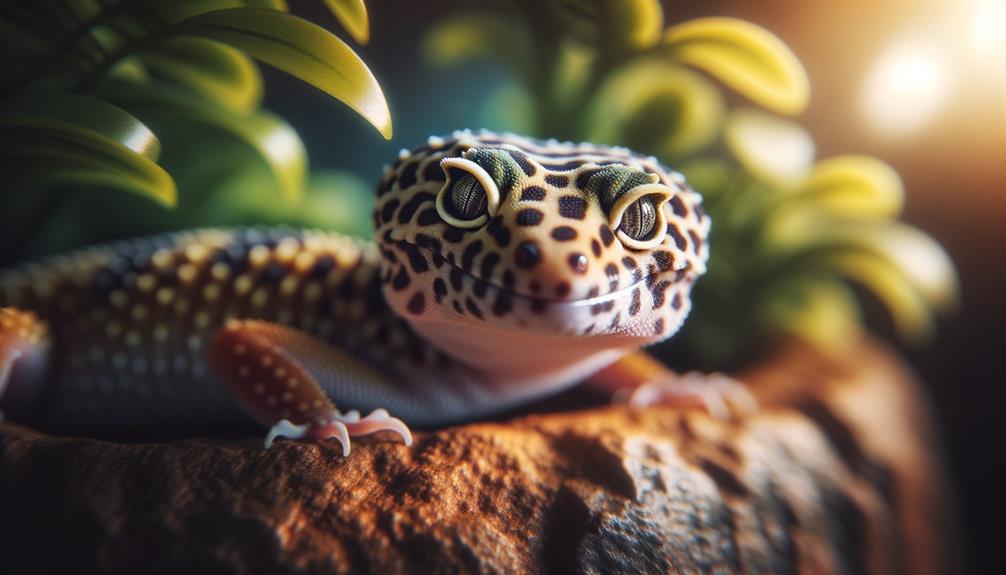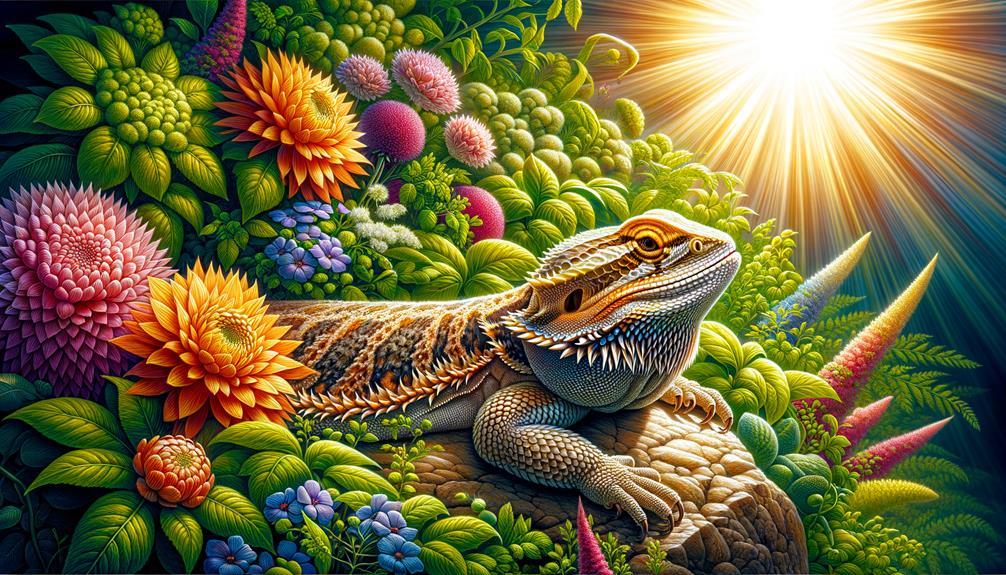Gila monsters are fascinating creatures, boasting striking black and orange patterns and beaded skin. As the largest lizards in the U.S., they inhabit the Southwestern U.S. and northwestern Mexico. These venomous dwellers use their grooved teeth to deliver venom, subduing prey like birds and small mammals. Their venom, comprising over 50 components, has even contributed to diabetes treatments. Thriving in semi-arid, rocky habitats, they make their homes in burrows and crevices. Unfortunately, habitat destruction has pushed them towards threatened status. Their unique adaptations make them an intriguing subject for researchers and conservationists.
Key Takeaways
Gila monsters possess a complex mixture of venom, comprising over 50 components, including neurotoxins and enzymes. When threatened, they deliver this venom through hollow fangs, causing intense pain as a defense mechanism. Interestingly, Gila monster venom has contributed to the development of diabetes medications. Reaching lengths of up to 22 inches, they are the largest lizard in the United States. These creatures thrive in the rocky, semi-arid regions of the Southwestern United States and northwestern Mexico.
Physical Description
When you encounter a Gila monster, you’ll immediately notice its sturdy build and striking black and orange or yellow patterns on its skin. This venomous lizard, native to the United States, commands attention with its vibrant appearance and robust physique. Reaching up to 22 inches in total length, the Gila monster is the largest lizard found in the United States, a testament to its formidable presence in the wild.
The broad, rounded head of the Gila monster is particularly striking. Its powerful jaws are equipped with enlarged, grooved teeth that play a crucial role in delivering venom, a unique adaptation that aids in subduing prey and deterring predators.
The skin of the Gila monster is also remarkable, featuring osteoderms – pearl-shaped bones embedded in the skin, giving it a beaded or studded appearance. This distinctive texture adds to its rugged charm and provides a degree of protection.
Understanding the physical description of this remarkable creature offers valuable insight into its survival strategies and evolutionary success, making the Gila monster a truly fascinating subject for study.
Venom Composition

Gila monster venom is an intricate mixture of over 50 components, including enzymes, peptides, and neurotoxins, making it a fascinating subject for scientific study. When a venomous Gila monster bites, it injects venom through its hollow fangs, causing excruciating pain. But this venom isn’t designed to kill quickly; instead, it serves as a potent defense mechanism.
One key component in Gila monster venom is helothermine, a protein that triggers intense, lingering pain in humans. This pain serves a purpose beyond being a deterrent; it’s a testament to the venom’s complex composition. The Gila monster’s unique ability to store fat in its tail while harboring such complex venom makes it a captivating subject for researchers.
Interestingly, this venom has also contributed significantly to medical advancements. Researchers have isolated a human hormone mimic, exendin-4, from the Gila monster’s venom, which led to the development of effective diabetes medications. This discovery highlights the venom’s potential beyond its defensive purpose, opening new avenues in pharmaceutical research.
Understanding the venom’s composition provides valuable insights for developing novel compounds, underscoring the Gila monster’s unique contribution to both nature and science.
Habitat and Range
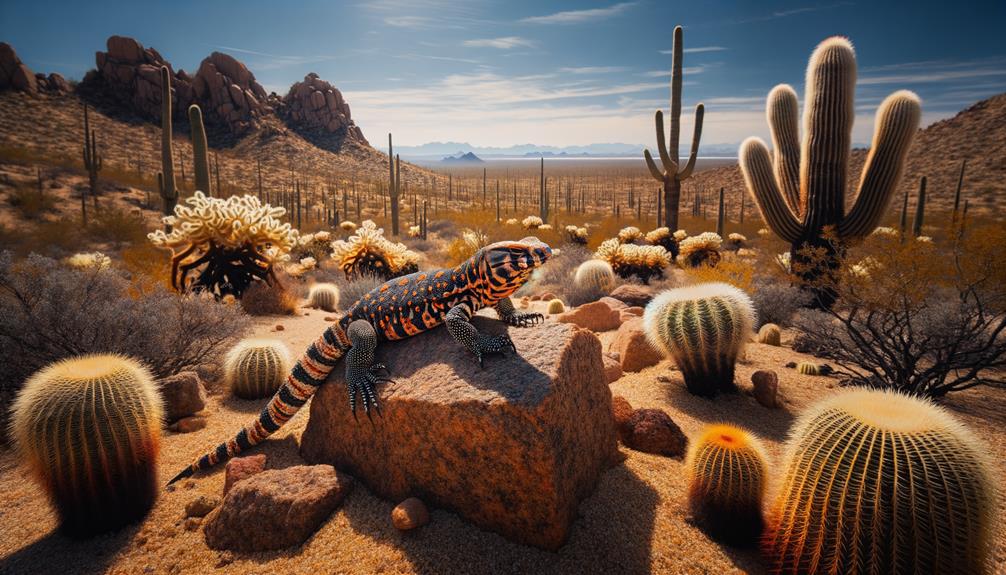
In the arid landscapes of the Southwestern United States and northwestern Mexico, the Gila monster has made the Sonoran Desert‘s rocky, semi-arid regions its home. These venomous lizards thrive in dry washes, scrub habitats, and elevations up to 5,000 feet, with their distribution centered around the Gila River Basin in Arizona and New Mexico.
Gila monsters are experts at survival, often taking shelter in burrows, crevices, and thickets to avoid open areas like grasslands and agricultural fields. They’ve developed a clever adaptation to cope with the desert’s extreme heat, able to decrease their body temperature by up to 2°C through limited evaporation.
Although they share their range with the Mexican beaded lizard, Gila monsters occupy a unique niche. Despite being classified as near threatened, they remain a vital part of their ecosystem. Their ability to consume up to one-third of their body weight in one sitting allows them to thrive despite the scarcity of prey.
Encountering a Gila monster bite in the wild is rare, but their presence serves as a reminder of the untamed beauty and complexity of the Sonoran Desert.
Diet and Hunting
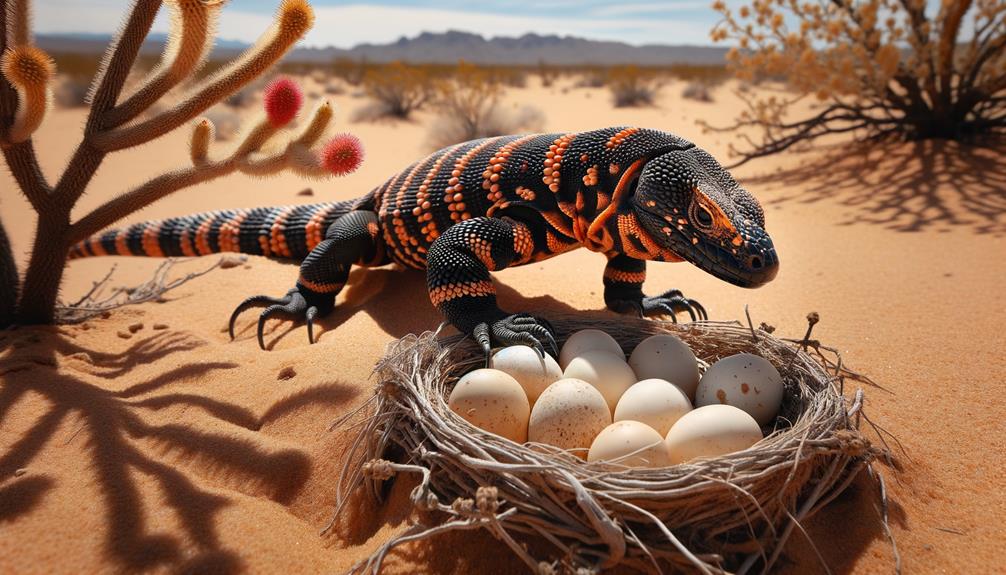
In the scorching Sonoran Desert, Gila monsters rely on a diverse diet to survive. They consume small mammals, birds, snakes, lizards, frogs, insects, carrion, and eggs. As venomous animals, they use their deadly bite to subdue prey.
These lizards are skilled ambush predators, often active in the morning when they patiently wait in hiding spots to attack. They can swallow up to 50% of their body weight in a single meal, storing energy and water to endure the harsh desert climate. Their keen sense of smell and two-ended tongue help them locate prey, ensuring they get the sustenance they need.
Their diet consists of:
- Small mammals: mice, rats, and other small rodents
- Small birds: ground-nesting birds and fledglings
- Eggs and lizards: reptilian eggs and smaller lizards
Gila monsters typically claim 3-4 extensive meals in the spring, providing energy for the entire season. Their venom plays a vital role in their hunting strategy, making them efficient and resilient predators in a challenging environment.
Conservation Efforts
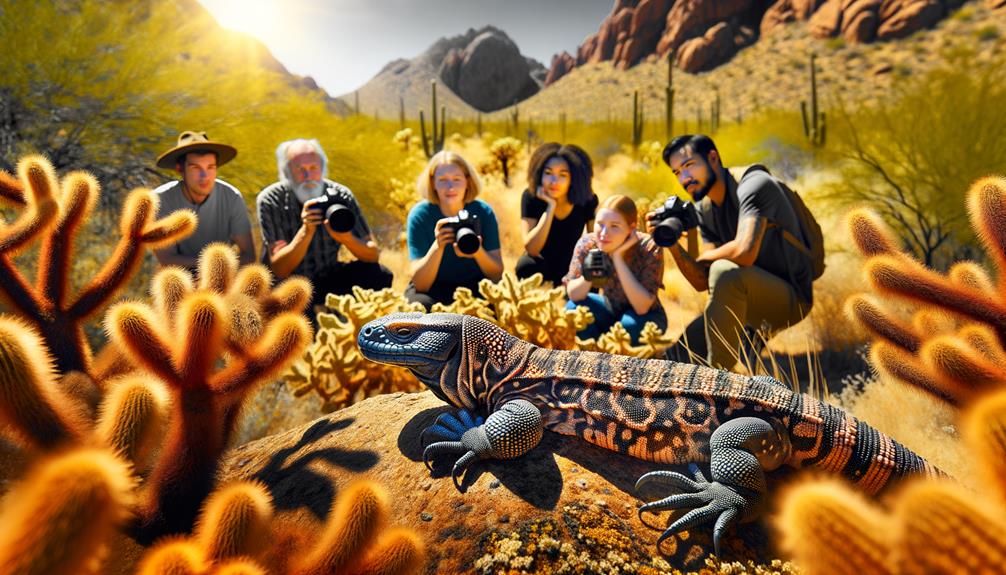
How can we ensure the survival of Gila monsters as threats to their habitat escalate? Classified as ‘near threatened‘ by the IUCN, these fascinating creatures, which spend much of their time hidden underground, are in dire need of protection. Habitat destruction poses a significant risk, requiring swift and decisive action.
A few years ago, a Colorado man made headlines when he survived a Gila monster bite. This incident highlighted misconceptions surrounding these lizards, whose venom, delivered through grooves in their lower jaw, has even inspired treatments for type 2 diabetes. Dispelling myths and raising awareness are crucial in fostering a protective attitude toward these misunderstood creatures.
Relocation efforts often fail, as Gila monsters tend to return to their original habitat within two months. Protecting their natural environment in states like New Mexico is, therefore, essential. While legal protection and trade regulation under CITES are steps in the right direction, more needs to be done.
Research into Gila monster adaptations to climate change is vital. By understanding how these resilient reptiles cope, we can develop effective conservation strategies. It’s crucial that these enigmatic dwellers thrive for generations to come.
Frequently Asked Questions
Do Gila Monsters Have Venom Glands?
Gila monsters do pack a punch with their venom glands! Imagine a creature with lower jaw factories mixing enzymes, neurotoxins, and cardiotoxins. It’s a natural cocktail of pain, designed to keep predators at bay.
What Are the Predators of a Gila Monster?
Gila monsters have natural predators like coyotes, badgers, raptors, and snakes. Adult Gila monsters are often preyed upon by coyotes and badgers, while hatchlings are targeted by raptors and snakes. These predators capitalize on the Gila monster’s slow movements and encroached habitats.
Has a Gila Monster Ever Killed a Human?
There was one documented case of a human fatality resulting from a Gila monster bite in 2024. While their venom is extremely painful, fatalities are extremely rare, making these creatures more fascinating than intimidating to those who appreciate freedom.
Why Is There No Antivenom for Gila Monster?
There’s no antivenom for Gila monster bites because they’re extremely rare and hardly ever fatal. Developing an antivenom would be a costly and impractical venture. Instead, medical professionals focus on managing pain and swelling locally, avoiding unnecessary pharmaceutical interventions.


